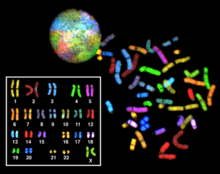Karyotype
The karyotype ( ancient Greek κάρυον karyon , nut, fruit core '; ancient Greek τύπος typos , stroke, character, shape, pattern', of which Latin type , character, shape, value ') designated in the cytogenetic (teaching on the relationship between heredity and cell structure) the totality of all cytologically (regarding the cell structure) recognizable chromosome properties of an individual or a group of genetically related individuals. These properties include the number of chromosomes in a cell as well as their formation, their relative and absolute size, the position of the centromere , secondary constrictions, specific band patterns and the chromatin distribution in the chromosome.
The karyotype is determined in that chromosomes in the metaphase of mitosis are made recognizable by chromosome staining and examined with a light microscope . For human genetic diagnostics , the chromosomes were photographed and then arranged in pairs to form a karyogram . Today, this is carried out with software support through image recognition on the monitor.
Use in human genetic diagnostics

The analysis of the karyotype can be used for various questions. It is used in human genetic diagnostics to detect light microscopic anomalies as a sign of hereditary diseases or spontaneous chromosome mutations. These include changes in the number of chromosomes, as they occur in trisomies , or chromosome mutations such as breaks, faulty mergers or duplications of a chromosome segment ( deletions , translocations , duplication). Gender can also be determined.

To describe the human karyotype, an abbreviated notation has become established that shows the total number of chromosomes , the type of sex chromosomes and, in clinical use, chromosomal abnormalities as well. In humans, this notation usually results in 2n = 46, XX for women and 46, XY for men. X and Y respectively stand for an X chromosome or a Y chromosome . In addition, special features among the autosomes can be specified at the end in the form of a number. Some known chromosome changes are appropriately named as follows:
- 45, X0 → karyotype of a girl / woman with Turner syndrome (Ullrich-Turner syndrome / monosomy X, i.e. one X chromosome is missing)
- 45, Y0 → karyotype in which one X chromosome is missing, lethal (fatal)
- 47, XXY → karyotype of a boy / man with Klinefelter syndrome (one additional X chromosome)
- 47, XYY → karyotype of a boy / man with diplo-Y syndrome (one additional Y chromosome)
- 47, XX + 21 → karyotype of a girl / woman with Down syndrome (trisomy 21)
- 47, XY + 18 → karyotype of a boy / man with Edwards syndrome (trisomy 18)
- 47, XY + 13 → karyotype of a boy / man with Patau syndrome (trisomy 13)
- 47, XXX → karyotype of a girl / woman with triplo X syndrome (an additional X chromosome)
Use in taxonomic research
In both botany and zoology , the study of the karyotype plays a role in taxonomic and phylogenetic research. In plants, karyotype analysis can provide insight into certain mechanisms of speciation, for example through polyploidization ; in animals, the karyotype often provides indications of evolutionary processes. For example, all great apes (Hominidae) apart from humans have a karyotype with 2n = 48 chromosomes. Detailed investigations showed that human chromosome 2 resulted from a fusion (see article Chromosome, section Chromosome evolution ).
Web links
literature
- Rolf Knippers: Molecular Genetics. 7th edition, Georg Thieme Verlag, Stuttgart 1997, pp. 154 and 155, ISBN 3-13-477007-5 .
- Keyword karyotype In: Herder-Lexikon der Biologie. Spektrum Akademischer Verlag GmbH, Heidelberg 2003, ISBN 3-8274-0354-5 .
Individual evidence
- ^ A. Jauch, J. Wienberg, R. Stanyon, N. Arnold, S. Tofanelli, T. Ishida, T. Cremer: Reconstruction of genomic rearrangements in great apes and gibbons by chromosome painting. In: Proceedings of the National Academy of Sciences . Volume 89, Number 18, September 1992, pp. 8611-8615, ISSN 0027-8424 . PMID 1528869 . PMC 49970 (free full text).
